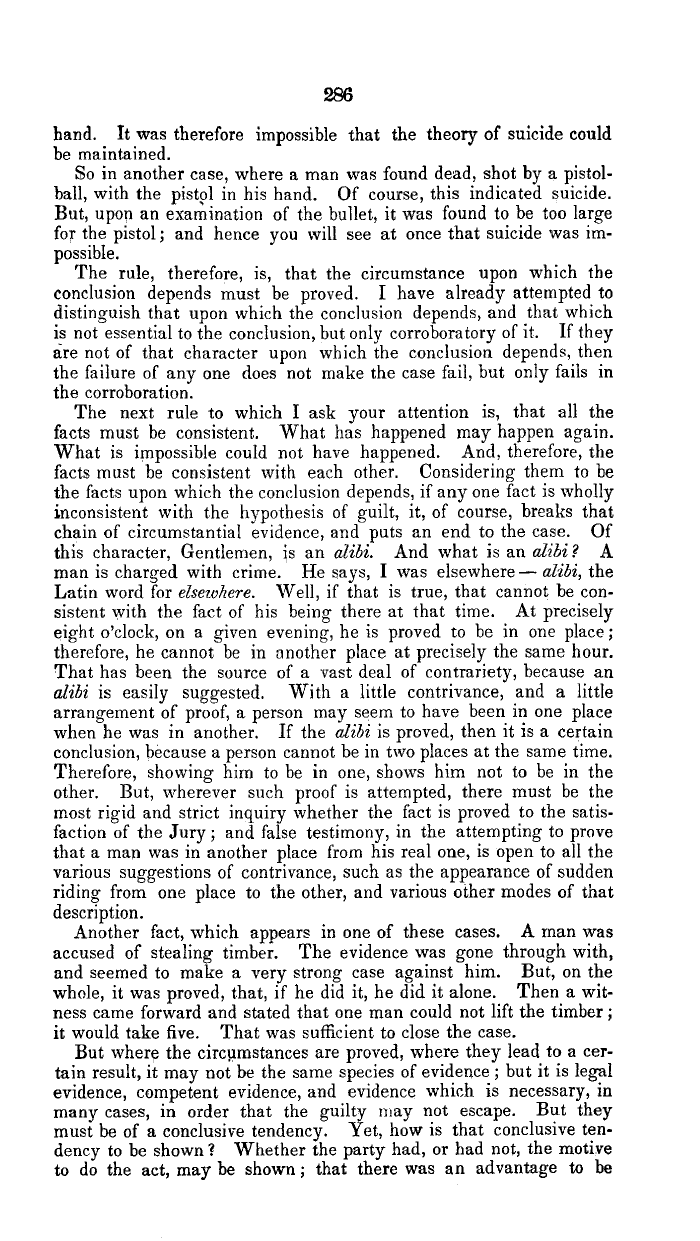|
286
hand. It was therefore impossible that the theory of suicide could
be maintained.
Sao in another case, where a man was found dead, shot by a pistol-
ball, with the pistol in his hand. Of course, this indicated suicide.
But, upon an examination of the bullet, it was found to be too large
for the pistol; and hence you will see at once that suicide was im-
possible.
The rule, therefore, is, that the circumstance upon which the
conclusion depends must be proved. I have already attempted to
distinguish that upon which the conclusion depends, and that which
is not essential to the conclusion, but only corroboratory of it. If they
are not of that character upon which the conclusion depends, then
the failure of any one does not make the case fail, but only fails in
the corroboration.
The next rule to which I ask your attention is, that all the
facts must be consistent. What has happened may happen again.
What is impossible could not have happened. And, therefore, the
facts must be consistent with each other. Considering them to be
the facts upon which the conclusion depends, if any one fact is wholly
inconsistent with the hypothesis of guilt, it, of course, breaks that
chain of circumstantial evidence, and puts an end to the case. Of
this character, Gentlemen, is an alibi. And what is an alibi ? A
man is charged with crime. He says, I was elsewhere- alibi, the
Latin word for elsewhere. `'yell, if that is true, that cannot be con-
sistent with the fact of his being there at that time. At precisely
eight o'clock, on a given evening, he is proved to be in one place;
therefore, he cannot be in another place at precisely the same hour.
That has been the source of a vast deal of contrariety, because an
alibi is easily suggested. With a little contrivance, and a little
arrangement of proof, a person may seem to have been in one place
when he was in another. If the alibi is proved, then it is a certain
conclusion, because a person cannot be in two places at the same time.
Therefore, showing him to be in one, shows him not to be in the
other. But, wherever such proof is attempted, there must be the
most rigid and strict inquiry whether the fact is proved to the satis-
faction of the Jury; and false testimony, in the attempting to prove
that a man was in another place from his real one, is open to all the
various suggestions of contrivance, such as the appearance of sudden
riding from one place to the other, and various other modes of that
description.
Another fact, which appears in one of these cases. A man was
accused of stealing timber. The evidence was gone through with,
and seemed to make a very strong case against him. But, on the
whole, it was proved, that, if he did it, he did it alone. Then a wit-
ness came forward and stated that one man could not lift the timber;
it would take five. That was sufficient to close the case.
But where the circumstances are proved, where they lead to a cer-
tain result, it may not be the same species of evidence; but it is legal
evidence, competent evidence, and evidence which is necessary, in
many cases, in order that the guilty may not escape. But they
must be of a conclusive tendency. Yet, how is that conclusive ten-
dency to be shown? Whether the party had, or had not, the motive
to do the act, may be shown; that there was an advantage to be
|

